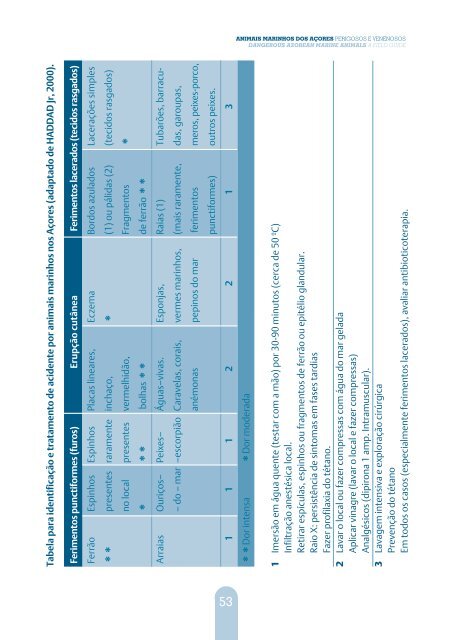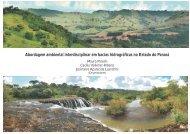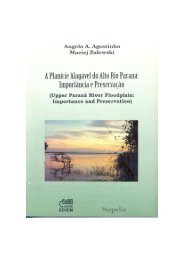You also want an ePaper? Increase the reach of your titles
YUMPU automatically turns print PDFs into web optimized ePapers that Google loves.
VIDAL HADDAD JÚNIOR<br />
JOÃO PEDRO BARREIROS<br />
Table for identification and treatment of accidents caused by marine animals from the Azores (adapted from HADDAD Jr, 2000).<br />
Punctiform wounds Coetaneous eruption Lacerated tissues<br />
Sting Sting Sting Linear marks, Eczema Bluish bords Simple lacerations<br />
** present rarely swelling, *<br />
(1) or pale (2) (torn tissues)<br />
* present reddening, Sting fragments<br />
*<br />
** burn marks<br />
** **<br />
Sting rays Sea Scorpion Medusae, Portu– Sponges, Sting rays (1) Sharks, barracudas,<br />
urchins fish and guese Man O’War, marine worms, (rarely, Punctiform groupers,<br />
their kin corals, anemones. sea cucumbers wounds) trigger fish,<br />
other fish.<br />
1 1 1 2 2 1 3<br />
Moderate pain<br />
** Intense pain *<br />
1 Immersion in hot water (test previously with hand) for 30-90 minutes (ca. 50 ºC)<br />
Local anaesthetic infiltration<br />
Remove spiculae, spines, sting fragments or glandular epithelium.<br />
X-ray: Persistence of symptoms on a late phase.<br />
Tethanic prophylaxis.<br />
2 Wash the area or make bandages with iced sea water.<br />
Apply vinegar (wash the area and make bandages)<br />
Analgesics (dipirone or equivalent. Intramuscular).<br />
3 Intensive washing and surgical exploration.<br />
Tethanic prevention.<br />
In all cases (especially on lacerated wounds), evaluate therapy with antibiotics.<br />
54






